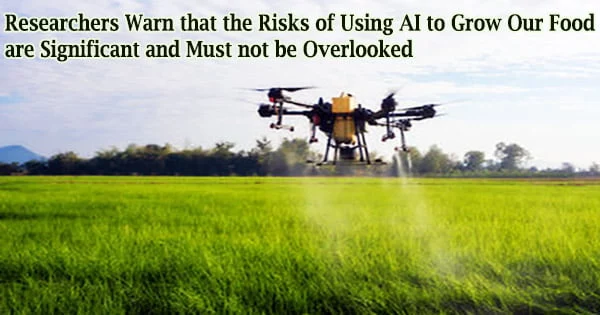Imagine a field of wheat that stretches all the way to the horizon, being produced for flour that will be used to make bread to feed entire towns.
Consider how all authority for tilling, planting, fertilizing, monitoring, and harvesting this field has been delegated to artificial intelligence: algorithms that control drip irrigation systems, self-driving tractors, and combine harvesters, all of which are capable of responding to the weather and the crop’s precise needs. Then image a hacker causing havoc.
According to a new risk study published today in the journal Nature Machine Intelligence, the future application of artificial intelligence in agriculture carries significant potential hazards for farms, farmers, and food security that are poorly understood and underappreciated.
“The idea of intelligent machines running farms is not science fiction. Large companies are already pioneering the next generation of autonomous ag-bots and decision support systems that will replace humans in the field,” said Dr. Asaf Tzachor in the University of Cambridge’s Centre for the Study of Existential Risk (CSER), first author of the paper.
“But so far no-one seems to have asked the question ‘are there any risks associated with a rapid deployment of agricultural AI?’” he added.
Despite AI’s enormous promise for improving crop management and agricultural productivity, the authors say that potential risks must be addressed responsibly and new technologies thoroughly tested in experimental settings to ensure that they are safe and secure against accidental failures, unintended consequences, and cyber-attacks.
The authors have developed a list of hazards that must be considered in the responsible development of AI for agriculture, as well as solutions to solve them, based on their research.
They warn that cyber-attackers might disrupt commercial farms employing AI by poisoning datasets or shutting off sprayers, autonomous drones, and robotic harvesters, among other things.
The idea of intelligent machines running farms is not science fiction. Large companies are already pioneering the next generation of autonomous ag-bots and decision support systems that will replace humans in the field.
Dr. Asaf Tzachor
To avoid this, they recommend that ‘white hat hackers’ assist corporations in identifying security flaws during the development phase, so that systems may be protected from genuine hackers.
The authors indicate that in a situation involving inadvertent failure, an AI system trained just to give the best agricultural output in the near term would overlook the environmental ramifications of doing so, resulting in misuse of fertilizers and soil degradation in the long run.
Pesticide overuse in the pursuit of higher yields might damage ecosystems, while nitrogen fertilizer overuse would pollute the soil and adjacent streams. To avoid these eventualities, the authors recommend integrating applied ecologists in the technology design process.
Farmers’ working conditions could be improved if autonomous machines relieve them of physical labor. However, without inclusive technology design, socioeconomic inequities such as gender, class, and ethnic discrimination would persist in global agriculture.
“Expert AI farming systems that don’t consider the complexities of labour inputs will ignore, and potentially sustain, the exploitation of disadvantaged communities,” warned Tzachor.
Various ag-bots and smart gear, such as drones and sensors, are already being used to gather data on crops and assist farmers in making decisions, such as detecting infections or insufficient irrigation.
Self-driving combine harvesters can also harvest a crop without the assistance of a human operator. These automated technologies are designed to make farming more productive by reducing labor expenses, increasing production efficiency, and reducing loss and waste. Farmers will see an increase in revenue as well as a higher reliance on agricultural AI as a result of this.
Small-scale producers, who cultivate the majority of farms around the world and feed significant expanses of the so-called Global South, are likely to be excluded from AI benefits.
Smallholders may be unable to use new technologies due to marginalization, low internet penetration, and the digital divide, expanding the gap between commercial and subsistence farmers.
Artificial intelligence technologies and precision agriculture promise significant benefits for food and nutritional security in the face of climate change and a growing global population, with an estimated two billion people suffering from food insecurity, including 690 million malnourished and 340 million children suffering from micronutrient deficiencies.
“AI is being hailed as the way to revolutionise agriculture. As we deploy this technology on a large scale, we should closely consider potential risks, and aim to mitigate those early on in the technology design,” said Dr. Seán Ó hÉigeartaigh, Executive Director of CSER and co-author of the new research.





